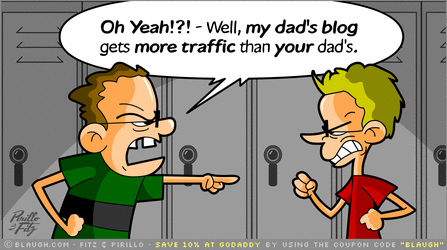by Lisa Mané, Head of Social Media, COI
No one can deny, especially as Mark Zuckerberg has been crowned Time Magazine’s person of the year, that social media in general and Facebook in particular have become mainstream, and in a cross-gererational way.
Some of our highlights of 2010 include the Old Spice and Tipex YouTube campaigns, The Social Network movie, UK hastags in general (e.g. #ashtag, #uksnow, #GE2010), and tv programme hashtags in particular (think BBC QT and Xfactor), and of course, our own sexworthtalkingabout FB actvity. In terms of data visualisation, we all love the map of the world through Facebook connections and the one inspired by that map using public data from data.gov.uk
Read more…
by , Tamar
There have been several ’stories’ in the past week or so which seem to highlight a worrying trend amongst ‘offline’ folk – that is, that bloggers are not worthy of the same respect as other forms of journalist or marketer.
Andrew Marr is probably the most vocal example, speaking at the Cheltenham Literary Festival this week. As reported by the Guardian, Marr apparently described blogging as:
“…so-called citizen journalism is the spewings and rantings of very drunk people late at night”
He went one step further, deciding that bloggers (presumably such a small group of people that they can be lumped in one single demographic) are not the sort of people he wants to be dealing with:
“A lot of bloggers seem to be socially inadequate, pimpled, single, slightly seedy, bald, cauliflower-nosed young men sitting in their mother’s basements and ranting. They are very angry people”

Thankfully, several other equally-prominent media folk have jumped to the defence of the bloggers in question – my favourite was Channel 4’s Krishnan Guru-Murthy, also writing in the Guardian:
“They might not be household names, or worthy of a slot on Radio 4, but to dismiss them out of hand seems wrong. As for bloggers being “inadequate, pimpled and single”, that’s no way to talk about Jon Snow. He isn’t single.”
Krishnan makes several very strong points in his reply (with very good humour, to boot) – but the point above really cristalises it for me. Bloggers might not be household names – though I’m sure if you surveyed a lot of households these days you’d be surprised by the result – but they are just as entitled to an opinion as every other commentator.
Worse still, to dismiss them as being not-worth-listening to simply because of the medium they choose to write on is just plain stupid. As a Marketeer, I regularly work with bloggers whose blogs get readerships of well over 100,000 unique users, some of whom none of you reading this will have heard of. But a journalist from the Financial Times – a newspaper with a readership of a little over 400,000 at last count – will be treated with respect and reverence by the journalism community. That doesn’t seem right to me.
More recently (today in fact) Twitter was abuzz with the story of Muireann Carey-Campbell, a blogger who had a nasty run in with a PR agency and a very large phone company. I won’t rehash the story here, as it’s been reported in numerous different places already today. Needless to say, it’s another example of a blogger being treated with much less respect than their more traditional peers. Despite the fact that both ‘guilty’ parties have since apologised, it’s such a shame that these situations only ever seem to get resolved when bloggers make a song-and-dance about it.
I can’t say I’m too surprised that old-media folk are on the defensive when it comes to bloggers – with pay-walls and over-hyped iPad applications supposedly forming the future of ‘real’ journalism, the winds of change are clearly blowing hard. As grown-ups and professional marketeers, it’s up to us to help bloggers prove their clout and show how influential they really are. Considering most of us are bloggers in both our spare and work time time too, I’d say the gloves are firmly off on this one…
By head of the social media council, IAB
You may have noticed, but here at the IAB we get excited about a lot of things.
But nothing gets us hot under the digital collar like the biannual IAB UK online adspend results, which hit the headlines today. Every six months, in partnership with PwC, we measure the size of the UK market to help marketers understand the true scale of the medium and to provide the digital industry with the ammunition it needs to make the case for even bigger budgets.
And what IS the headline? Well, we hit a really-quite-perfect 10% in terms of year-on-year growth, with every format within online (search, display and classifieds) seeing an increase in advertising investment. The medium hit almost £2 billion in just six months, with an impressive 24.3% market share. Good news all round.
You can read the official story on the IAB site, but what readers of this blog might be interested in is where ‘social’ fits within this online success story.
Just to be clear, the figures set out in the IAB/PwC study refer to advertising expenditure online, so no production or agency costs are included… this means that a lot of social spending – i.e. money spent on creative, budgets dedicated blogger outreach programmes, social media monitoring costs and so on – doesn’t feature amongst the results. That figure, I would imagine, is pretty damn big on its own.
But what we can measure in this study is the advertising that lives on social networks, blogs, forums, online communities and so on, and this is now a whopping 13% of all online display (all online display was worth £334.6 million in H1 2010, so you do the math!) Last year we estimated social to account for around 10% of all online display, and if you cast your minds back just a few years ago… well, it was barely on the adspend radar. Read more…

Photo via audreyjm529 on Flickr
by , Tamar
The online community has been buzzing for the past 24 hours, first in anticipation-of and now digesting the ramifications-of the ‘‘. Announced just after midnight on Tuesday (UK time), Twitter have completely revamped their website to give more space to a number of new features.
If you want the headline view, I wrote a blog early this morning on the subject – but I wanted to head over here to the IAB social blog to speculate over how these changes might affect advertisers…
The main areas of change that will probably affect brands are:
The new, all-inclusive, super-sticky site will undoubtedly encourage a lot of tweeters who previously used the service through third-party apps and sites to come back to Twitter.com – which in turn will obviously increase the exposure that existing advertisers receive. Recent developments like Sponsored tweets, promoted trends and the like are already making waves, but are only visible to people visiting Twitter.com. This massive increase in page-views will surely make advertising directly with Twitter a much more attractive proposition.
The new layout also gives much greater opportunity for tweeters (and brands) to give exposure to great media content, without ever leaving the site. Partnerships with services like YouTube, Flickr and Vimeo will mean that video and image content (amongst others) will be viewable directly in your Twitter stream – as my boss and Tamar’s CEO commented this morning, with ‘New Twitter’ it’s quite likely that the Old Spice ‘guy’ would have become a sensation on Twitter, as opposed to mainly on YouTube…
Finally, the third consideration for brands and advertisers will be how this affects third-party sites that they might currently be advertising on. As this post by Mashable points out, the New Twitter is essentially a desktop app, on the web. Services like TweetDeck, Hootsuite and the like will undoubtedly feel the pinch after New Twitter rolls out, so if you advertise with them you might be in for a drop in views. Just speculation of course, but I can’t see how this WON’T affect those apps…
With the roll-out set to continue over the next couple of weeks, many of the ramifications will only start to be felt in the next month or so, but even at this early stage it’s clear to see the ‘New Twitter’ will be a much more welcome place to advertisers, brands and users alike…
By Iain MacMillan, RMM
Over on the RMM blog, we explained what Facebook Places was, how it worked and who might use it.
While that post looked at how Facebook’s users might use Places, we’ve also been thinking about what advantages the new feature offers brands – particularly over Foursquare.
Currently, Foursquare users get the benefit of social gaming through collecting badges, discounts from brands like Starbucks and a new kind of interaction with friends. Facebook currently offers only the last of these three options. It hasn’t stolen the mechanism of rewarding users through badges, nor has it benefited from a lucrative partnership like Starbucks offering Foursquare power users free coffee. But Facebook Places may have the sheer might needed to expose a brand to large, hitherto untapped networks of friends, colleagues and family.
Facebook has a ready-made user base
, Foursquare has 2.5 million users. Very impressive for a start-up but in hard numbers barely comparable to . With such a massive user base, it will be Facebook Places and not a single-serving start-up which pushes geo-location into the mainstream over the next few years. There is little incentive to add users to your Foursquare network when they can access your status updates publicly via Twitter. But Facebook is a closed network; Places provides a new way in for brands.
This means any brand reliant on a bricks-and-mortar location should be quick to claim their postcode on Facebook Places – the quicker the uptake, the more noticeable to users. More so than Foursquare, if a user checks into your Facebook Place it will display to a potentially massive network of prospective customers. Brands who have marked themselves on Places may find themselves as a meeting or talking point among large networks of friends who have tagged themselves and each other on check-in.
Places will affect your fan page
There’s an option for any brand with a Facebook fan page to ‘merge’ this with the new Places functionality. Doing so will update your page design to reflect a map of your location and – importantly – status updates of everyone who has checked in there, whether a fan of your page or not.
Unfortunately there’s a flaw –this doesn’t really work for any brand with multiple locations to map. The natural step from here would be to consider creating individual pages for individual stores; creating smaller but potentially more loyal communities around single locations and also driving footfall.
Facebook is brand-friendly
Out of all the mainstream social media platforms, Facebook is the most nakedly interested in making money out of its users – for better or worse. Its swift release of the Places advertiser guidelines, despite technical teething problems with the new feature, suggests Facebook is keen to broadcast Places as an opportunity for brands as much as users. It is very much in Facebook’s interest to ensure brands can exploit Places for commercial advantage more quickly, easily and cost-effectively than the rival Foursquare over the upcoming months – which is why, as a brand, it would be smart to keep an eye on it.
By , Head of Digital Media, Royal Opera House
 Pretty much every UK arts organisation now has a full-set of social-media cards: YouTube channel? Check. ? Yes indeed. Obligatory ? Why, yes of course. These combine with Flickr and Audioboo, blogs and wikis, podcasts and video channels to create a new kind of cultural landscape in which an audience member might never need to enter a gallery or auditorium to feel like they’ve seen the show.
Pretty much every UK arts organisation now has a full-set of social-media cards: YouTube channel? Check. ? Yes indeed. Obligatory ? Why, yes of course. These combine with Flickr and Audioboo, blogs and wikis, podcasts and video channels to create a new kind of cultural landscape in which an audience member might never need to enter a gallery or auditorium to feel like they’ve seen the show.
But why are we doing it? Just like consumer brands, cultural organisations want to spend more quality time with people who care, or might grow to care, about them. The majority also need to cultivate customer loyalty and develop new, paying audiences. There are also traditional customer-service objectives to fulfil, and aspirations for brand building and international profile. But there are other motivations that make the challenge of creating a cultural social-media strategy more complex to execute, and success more difficult to measure. Read more…
, commercial director at Unruly Media explains what viral success looks like and how you measure it. Steve also talks about the vital characteristics your video needs to make it stand out and have the ‘shareable’ factor, using ‘Charlie bit my finger’ as an example.
Watch the below videos to see the interview in full…
Simon Daglish vice president of Fox Interactive Media was interviewed by , senior PR and marketing manager at the Internet Advertising Bureau (IAB) about how to engage with your audience within social media and the importance of keeping them captivated. Simon was asked questions such as; whether it is better to engage the user instead of chasing the last click, do clients still require proof to use social media? and should measurement be bespoke per campaign? He also gave some useful advice for managing friends and fans in social networks.
Watch the below video to see the full interview…
By Amy Kean, senior PR and marketing manager, IAB.
 Yesterday we (the IAB) released the latest results from our biannual online adspend report with PwC, and it’s fantastic news.
Yesterday we (the IAB) released the latest results from our biannual online adspend report with PwC, and it’s fantastic news.
Numerous analysts predicted that the medium was set to experience a decline in revenues in 2009, with others believing it would remain static at best. In reality online adspend actually grew 4.2% throughout last year, topping just over £3.54 billion.
But what does this mean, I hear you cry? Well let’s refrain from comparing online with other media for a second, and instead look at it in the context of the wider UK economy. We’ve done our research, and it turns out that the online advertising market, at £3.5 billion, is the same size as the UK dairy industry.
IT’S THE SAME SIZE AS MILK AND CHEESE!
Even more interesting? It’s the same size as the UK commercial sandwich industry. So there you have it fact fans, online is also as essential to the economy as BLTs. (But not the side orders like salad, Kettle Chips, Branston Pickle etc.)
Whilst in other media outlets we talk about the breakdown of the different formats (search, classifieds and display) and what sectors are spending the most in online, my favourite stat from this report is a secret one that I’ve saved for this blog, and one that we chose not to include in the press release.
Much has been made about the growth of social networks and the significant part they play in the digital economy, but until now the IAB has never really had much data to back this up within the PwC study. However in 2009 we have been able to estimate that social networks and community sites in the UK now represent around 9.3% of all online display – an impressive figure, given that a few years ago, it probably would have been pretty non-existent! So there’s the proof, social media contributes significantly to online ad revenues, it’s growing, and no doubt we can look forward to it getting bigger and better next year.
By , Sales Group Head, .
 There through choice? Yes. Loyal? Yes. ENGAGED? YES. Social Media users are arguably the most lent forward of all those online, real people logging into their own space online, adding that extra level of potential Engagement for brands, not achievable through other platforms. So, advertisers are embracing this and spending huge amounts of Sponsorship/Engagement budget in Social Media, right? Not really.
There through choice? Yes. Loyal? Yes. ENGAGED? YES. Social Media users are arguably the most lent forward of all those online, real people logging into their own space online, adding that extra level of potential Engagement for brands, not achievable through other platforms. So, advertisers are embracing this and spending huge amounts of Sponsorship/Engagement budget in Social Media, right? Not really.
Social Media is to online, what Cinema is to broadcast, it is the part of the online mix that can really help drive consideration, awareness, propensity etc with a captivated audience, all very valuable measures, some of which seem to have been forgotten in this age of clicks and acquisitions.
I am not saying that online can’t do a fantastic direct response job, we all know it can, this too is an area that needs a marketers attention. But now is the time to undo some of that damage you may have done to your brand equity by placing a standard banner within a social network, and then only measuring success by click through rates. There is a whole depth to its effect that is often ignored.
Vodafone, Unilever, COI, are a few of the brands that understand Social Media is ‘not just for Christmas’ and increasingly brands are getting the idea that these are not impression farms but communities brimful of real people, I am loving the Marmite’ election’ campaign that has just been announced. Real people need to be entertained, enticed, emotionally stimulated, all the things we would expect when paying for a ticket to the Cinema, or for a gig by one of your favourite artists, and like voting for the Tories, Lib Dems or Labour, deciding whether you ‘love it’ or ‘hate it’ is a decision not to be taken lightly.



 Yesterday we (the IAB) released the
Yesterday we (the IAB) released the 


